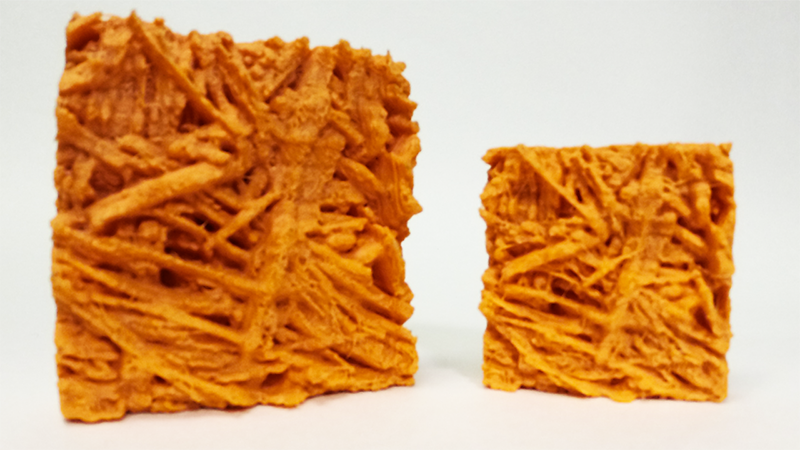[Andres] is working with an Atomic Force Microscope, a device that drags a small needle across a surface to produce an image with incredible resolution. The AFM can produce native .STL files, and when you have that ability, what’s the obvious next step? That’s right. printing atomic force microscope images.
The AFM image above is of a hydrogel, a network of polymers that’s mostly water, but has a huge number of crosslinked polymers. After grabbing the image of a hydrogel from an Agilent 5100 AFM, [Andres] exported the STL, imported it into Blender, and upscaled it and turned it into a printable object.
If you’d like to try out this build but don’t have access to an atomic force microscope, never fear: you can build one for about $1000 from a few pieces of metal, an old CD burner, and a dozen or so consumable AFM probes. Actually, the probes are going to be what sets you back the most, so just do what they did in olden times – smash diamonds together and look through the broken pieces for a tip that’s sufficiently sharp.















I recall a lecturer telling me that for probes for his own DIY AFM he would simply grab a piece of solid copper wire and snip off the end with a pair of cutters, once every few cuts this would lead to a sufficiently sharp piece. Also he suggested that you could probably get the necessary hardware now for under 100 bucks. That said, I don’t recall what resolution/performance he achieved or how it compared to this particular AFM.
He meant stm. That works for stm because all you need is a sharp enough tip.
Afms either have a tuning fork, or an oscillating cantilever. Prices go up to $200 each
They drop a little bit, lets say 30$ per tip
The type of tip depends very much on the function (either atomic force (AFM) or scanning tunnelling microscopy (STM)) and where you’re doing it, either in vacuum or in ambient conditions. For scanning tunnelling microscopy we can get away with platinum:iridium wire (80:20%) using the pair of cutters method as mentioned above for ambient conditions, a couple of meters cost a few hundred pounds but you only need a little bit at a time so it lasts ages. This gives us pretty reliably an almost atomically sharp tip which is fine to detect the tunelling effect and image things like graphene. I’ve never come accross anyone who uses copper since it will usually be pretty reactive and not last long without oxidising or reacting if the experiment is done in liquids. In vacuum condition experiments normally an electrochemically etched tungsten wire is used and the tip can be recovered normally by smashing it (very gently) into the sample to reform it as changing over a tip in a vacuum chamber isn’t trivial.
The difference with an atomic force microscope is that the tip (normally) needs to be mounted on a deflecting cantilever so that the force interaction can be measured and the tip oscillated over the surface. Whist it is possible to mount an etched tip onto a cantilever (they actually use regular quartz watch tuning forks as the cantilever) they are hard and laborious to make and are unnecessary unless you are working in vacuum at low temperature at the cutting edge of atomic scale measurements and cost £400+. For most commercial and academic instruments atomic resolution isn’t at all necessary (e.g. imaging cells and other bio/materials science stuff) and tips with a sharpness of a couple of nanometers can be made pretty cheaply using microfabrication techniques where they grow tips onto etched silicon wafers. The price range is pretty massive depending on what you need them for, anywhere from <£10 per tip up to a couple of hundred £ each for high speed scanning ones. That being said in the lab I work in, we have been able to get atomic resolution using a tip costing about £7 each.
Source: I'm a nanoscience PhD student who is definitely going to be trying this idea out.
Thanks for the explanation!
He then printed a hundred more, placed them into a bowl and added milk for a tasty breakfast. Seriously though, this is actually really neat. Hydrogels are used as support materials for bioprinting.
Great job, thanks for sharing!
Do you want fries with that atomic burger?
Ironically, those pills used to lose weight are made of hydrogel.
Can I 3D Print those pills?
Nice tutorial! It’s good to see how high tech can get profit of 3D printer… where is the stl?
Seriously neat project.
Floating around somewhere on the web is an old website where a guy built a scanning tunneling microscope. It used to be on Geocities, but sadly I can’t find it now. He used a cheap piezo disc buzzer as a scanning mechanism by cutting the electrode into four quadrants and driving them with the correct polarity. It could tilt/translate and move up/down.
For tips, I think he rigged up an etching system to produce very sharp tips – again, I can’t remember.
New comment so I get the email notifications….
That would be really good for high school science classes. You’d actually get to see and feel what tiny things are really like, instead of just looking at 2D pictures.
I thought this article was going to be about using such a microscope AS a 3d printer, to build finely crafted items up atom by atom. Get on it.